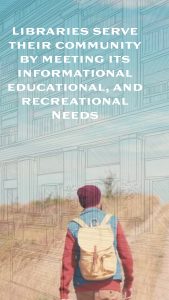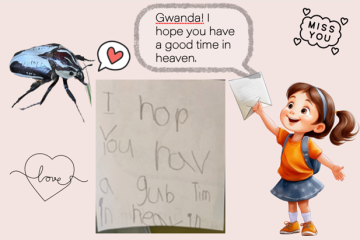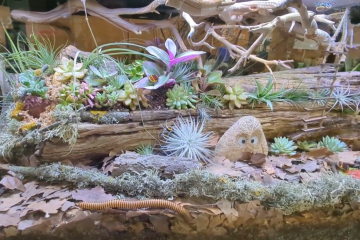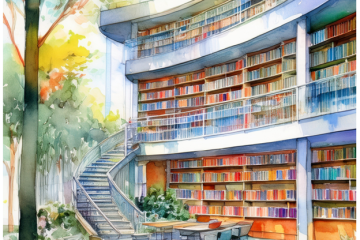Reflection 5 Infinite Learning–The Library as a Self-Service Classroom for Lifelong Learning

Image designed by Yiwen Liao via Adobe Express
The Library as a Self-Service Classroom for Lifelong Learning
According to the American Library Association (ALA), libraries serve their communities by meeting their informational, educational, and recreational needs (ALA, 2018). The San Francisco Public Library (SFPL) supports this mission through a self-service, user-centered environment that fosters lifelong learning. Its mission, strategic goals, and participatory service design reflect this commitment.
Informational Needs
SFPL provides barrier-free access to a wide range of informational resources. Ferrell’s article, “13 Free Things You Can Do with an SFPL Library Card,” highlights that patrons can access digital materials such as eBooks, online databases, LinkedIn Learning, and tutoring services (Ferrell, 2022). These offerings enable users to independently explore topics of interest and gain new knowledge. Additionally, SFPL supports community information needs through curated programming, workshops, and the opportunity for patrons to suggest new titles via their library accounts, ensuring that services are continually responsive to evolving user demands. This focus on user engagement aligns with van der Sluis’s (2025) assertion that search and learning behaviors are driven by curiosity and uncertainty, particularly in casual leisure contexts like public libraries.
Educational Needs
SFPL’s commitment to education is grounded in its mission to “connect our diverse communities to learning, opportunities, and each other” (Library Administration, n.d.). Through its Vision 2030 strategic plan, SFPL identifies roles such as Literacy Champion to guide its educational initiatives. These roles promote independent learning and lifelong education. SFPL provides educational programs such as:
- Summer Stride is the Library’s annual summer learning, reading, and exploration program for all ages and abilities. Read and learn with the Library all summer long.
- The Bridge at the SFPL Main Library is a literacy and learning center where you can find resources, classes, and people who can help.
Resources like free access to online learning platforms, workshops on various topics, and structured spaces such as “The Mix” for teens reflect SFPL’s educational impact. These user-centered learning environments are grounded in participatory design and align with Michael Stephens’ (2014; 2016) vision of libraries as open, infinite learning spaces.
Recreational Needs
SFPL also supports the community’s recreational needs by providing programs that stimulate creativity and enjoyment. Through its Discover & Go program, library cardholders can reserve free tickets to local museums, cultural institutions, and events—creating meaningful, low-barrier leisure opportunities. The California State Library Parks Pass provides free vehicle day-use entry into a participating state park, and you can visit more than one state park while you have the pass checked out.
The library also hosts a variety of interest-based workshops, events, and reading programs, allowing patrons to pursue hobbies, explore new interests, or simply relax and enjoy the resources. These offerings promote recreational learning and personal enrichment in a casual and inviting setting.
A Participatory, Lifelong Learning Environment
SFPL’s emphasis on user participation and self-direction is consistent with Library 2.0 principles (Casey & Savastinuk, 2007), encouraging feedback, personalization, and co-creation. By inviting users to shape their own experiences and contribute to the library’s development, SFPL empowers patrons to become active participants in their learning journey.
In summary, SFPL’s self-service, user-centered, and participatory design model not only addresses the informational, educational, and recreational needs of its community, but also reinforces the library’s role as a space for exploration, creativity, and connection throughout all stages of life. As a library staff member and patron, I’ve registered for many workshops during my free time and shared these opportunities with friends, experiencing firsthand how SFPL promotes accessible, self-paced learning.
References:
Ferrell, J. (2022, September 15). 13 Awesome Free Things You Can Do With An SF Public Library Card. Secret San Francisco. https://secretsanfrancisco.com/sf-public-library-card/
Library Administration. (n.d.). Sfpl.org. https://sfpl.org/about-us/library-administration
Stephens, M. (2014). Making The Case for the Library as a Space for Infinite learning
Mathews, B. (2013). Curating learning experiences: A future role for librarians?
Casey, M. E., & Savastinuk, L. C. (2007). Library 2.0 : A guide to participatory library service. Information Today, Inc..
Vision 2030. (n.d.). https://sfpl.org/sites/default/files/2024-03/ITEM-3.3-Strategic-Plan-FINAL.pdf
Van der Sluis, F. (2025). Wanting information: Uncertainty and its reduction through search
engagement. Information Processing & Management, 62(2), 103890-. https://doi.org/10.1016/j.ipm.2024.103890
(n.d.). Objectives [Review of Objectives]. American Library Association. https://www.ala.org/tools/challengesupport/selectionpolicytoolkit/objectives



0 Comments